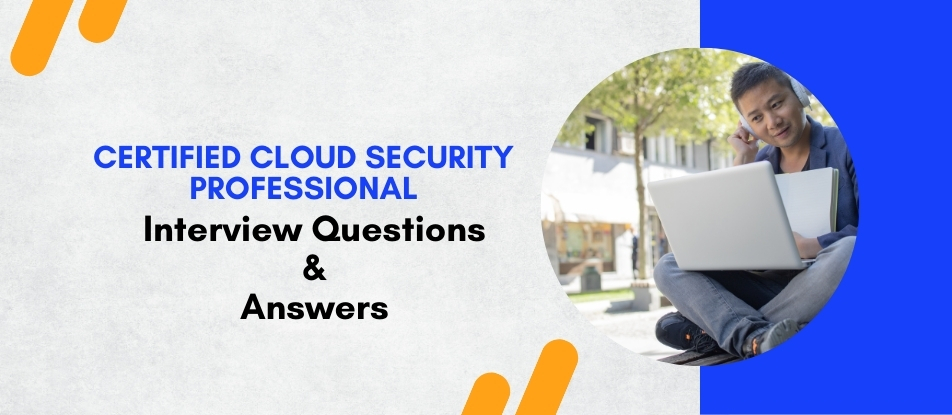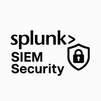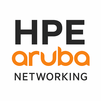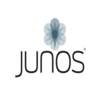
Dive into the world of cloud security with our Certified Cloud Security Professional training. This course is designed for IT and security professionals who aim to gain a comprehensive understanding of cloud security principles, architecture, and operations. Participants will learn about cloud data security, infrastructure security, regulatory frameworks, and risk management. The training prepares you for global certification, enhancing your ability to design and implement secure cloud environments effectively.
Certified Cloud Security Professional Interview Questions Answers - For Intermediate
1. What role does compliance play in cloud security?
Compliance ensures that cloud services adhere to industry standards and regulatory requirements, which helps protect data and maintain trust with stakeholders. It involves regular audits, certifications, and following best practices in data protection and privacy.
2. Describe the concept of cloud bursting. How does it affect security?
Cloud bursting is a configuration set-up that allows a system to switch to a public cloud when the demand exceeds the capacity of a private cloud. This transition needs to be managed securely to prevent data leaks and ensure consistent security policies across both environments.
3. How do application programming interfaces (APIs) impact cloud security?
APIs are crucial for enabling the interoperability and management capabilities of cloud services. However, they also present security risks if not properly secured, as they can offer hackers a pathway to sensitive data if exposed or misconfigured.
4. What is cloud sprawl, and how can it be controlled to enhance security?
Cloud sprawl refers to the uncontrolled proliferation of cloud instances or services, often due to a lack of central oversight. It can be controlled by implementing policies for cloud usage, regular audits of cloud resources, and ensuring proper decommissioning of unused services to reduce security vulnerabilities.
5. Discuss the importance of network segmentation in the cloud.
Network segmentation divides the cloud network into smaller, manageable, and secure zones. It enhances security by limiting the spread of breaches within segments and reducing the lateral movement of attackers across networks.
6. What are some challenges in securing cloud-native applications?
Challenges include managing complex service architectures, ensuring security across multiple services and interfaces, and dealing with dynamic and scalable environments. Ensuring consistent security practices and using automated tools for continuous security are essential strategies.
7. Explain the role of artificial intelligence in cloud security.
Artificial intelligence can enhance cloud security by automating complex processes for detecting and responding to threats in real time. AI-driven security systems can analyze vast amounts of data to identify patterns that indicate potential security breaches.
8. What is the significance of security posture management in the cloud?
Security posture management involves continuously assessing and improving the security state of cloud environments. It includes identifying vulnerabilities, applying necessary patches, and ensuring all security measures are up to date to protect against evolving threats.
9. How do service level agreements (SLAs) impact cloud security?
SLAs define the level of service provided by the CSP, including security expectations, response times for incidents, and uptime guarantees. Ensuring robust SLAs helps in setting clear security responsibilities and expectations between the customer and the CSP.
10. What are cloud security posture management (CSPM) tools, and how do they function?
CSPM tools automatically identify and remediate risks across cloud infrastructures. They help in managing the security posture by providing visibility into configurations, compliance, and managing the overall security state of cloud platforms.
11. Explain how forensic analysis in the cloud differs from traditional environments.
Forensic analysis in the cloud is challenging due to the dynamic nature of cloud environments, multi-tenancy, and the distributed nature of data. Specialized tools and procedures are required to securely collect and analyze forensic data without compromising the integrity and legality of the evidence.
12. What measures can be taken to secure serverless architectures in the cloud?
Security measures for serverless architectures include applying the principle of least privilege, securing dependencies and third-party libraries, ensuring robust access controls, and monitoring functions for unusual activities.
13. How does the use of microservices architecture affect cloud security?
Microservices architectures increase complexity in terms of security management due to the distributed nature of services. Securing individual components, implementing robust communication security, and employing automated security testing is crucial.
14. Discuss the impact of regulatory frameworks like GDPR on cloud security.
Regulatory frameworks like GDPR impose strict guidelines on data protection and privacy. For cloud security, this means ensuring data is processed and stored in compliance with legal requirements, which involve encryption, secure data handling practices, and clear data governance policies.
15. What is the significance of threat intelligence in managing cloud security?
Threat intelligence involves collecting and analyzing information about potential or current attacks that could threaten the cloud environment. It is crucial for proactive security as it helps organizations anticipate security threats and take preventive measures.
Certified Cloud Security Professional Interview Questions Answers - For Advanced
1. How do you ensure continuous compliance and security assurance in dynamic cloud environments?
Continuous compliance and security assurance in dynamic cloud environments require automation and continuous monitoring. Implementing tools like Cloud Security Posture Management (CSPM) and Cloud Workload Protection Platforms (CWPP) can help automate compliance checks and security assessments to ensure configurations and deployments adhere to best practices and regulatory requirements continuously. Integrating security into the CI/CD pipeline ensures that security checks are performed automatically during software deployments. Regularly updating security policies to adapt to new threats and changes in compliance requirements, coupled with ongoing training for all personnel involved in cloud operations, is also crucial. Establishing a continuous feedback loop where security assessments inform policy updates, which in turn guide the development and deployment processes, can help maintain a high level of security assurance.
2. What are the implications of using public Wi-Fi on cloud security, and how can these risks be mitigated?
Using public Wi-Fi can pose significant security risks, particularly due to the potential for man-in-the-middle attacks, where an attacker intercepts data between the user's device and the cloud. To mitigate these risks, VPNs (Virtual Private Networks) should be used to encrypt data in transit, effectively securing communications from eavesdropping or tampering. Additionally, employing multi-factor authentication can provide an extra layer of security, ensuring that even if network traffic is intercepted, the information alone is not enough to gain unauthorized access. Educating users about the risks associated with public Wi-Fi and providing them with the tools and knowledge to use secure methods of connection is also vital.
3. Evaluate the security considerations for adopting Internet of Things (IoT) technologies in the cloud.
Adopting IoT technologies in the cloud introduces several security considerations due to the increased attack surface and the diversity of IoT device capabilities and security features. Security considerations include ensuring robust device authentication and secure communications, managing device updates and patches to address vulnerabilities, and implementing strong data protection measures for the potentially sensitive information collected by IoT devices. Centralized security management systems can help monitor and manage security across diverse IoT devices and environments. Additionally, segmenting the network to isolate IoT devices from critical network segments can reduce the risk of cross-system attacks. Regular security assessments and adherence to industry standards and best practices for IoT security are also essential to mitigate risks associated with IoT in the cloud.
4. How can organizations effectively utilize Security-as-a-Service (SecaaS) in cloud environments?
Security-as-a-Service (SecaaS) offers a way for organizations to outsource the management of various security functions to cloud providers, enabling them to benefit from expert management and the latest security technologies without significant in-house investments. Effective utilization involves selecting reputable SecaaS providers who can offer services that align closely with the organization's security needs and compliance requirements. Integrating SecaaS into the existing security infrastructure requires careful planning to ensure that there are no gaps or overlaps in coverage. Continuous monitoring and evaluation of the SecaaS effectiveness, coupled with regular security audits, ensure that the security services provided remain effective and adapt to new threats.
5. Discuss the importance of cloud forensic readiness in the context of incident response.
Cloud forensic readiness is an integral part of incident response that prepares an organization to handle legal and investigative actions following a security incident. It involves having the processes and capabilities in place to collect, preserve, and analyze digital evidence without compromising its admissibility in legal proceedings. Key aspects include defining clear policies for data handling and retention, ensuring that logs and data are collected in a forensically sound manner, and maintaining a chain of custody for all evidence. Effective cloud forensic readiness reduces the time and cost associated with forensic investigations and enhances the ability to trace and attribute security breaches, which is crucial for legal and regulatory compliance.
6. What strategies should be employed to secure mobile cloud computing environments?
Mobile cloud computing introduces additional security challenges due to the inherent risks associated with mobile devices and their diverse operating systems and applications. Strategies for securing mobile cloud computing include implementing strong authentication mechanisms, securing data transmission through encryption, and managing devices using Mobile Device Management (MDM) or Enterprise Mobility Management (EMM) tools. These tools can enforce security policies, manage device configurations, and isolate corporate data from personal data. Regular security assessments and user training on secure mobile practices are also crucial to mitigating risks associated with mobile cloud computing.
7. How does DevOps integration affect cloud security, and what measures can be taken to secure DevOps environments?
Integrating DevOps into cloud security often referred to as DevSecOps, involves embedding security practices at every stage of the software development and deployment lifecycle. This integration can enhance security by promoting faster response to vulnerabilities and more proactive security measures. To secure DevOps environments, it's important to implement automated security testing tools, such as static and dynamic code analysis tools, throughout the development process. Security policies should be enforced through automated configuration management tools, and access to production environments should be tightly controlled. Cultivating a culture where security is everyone's responsibility and promoting continuous security training are also vital components of a secure DevOps practice.
8. Evaluate the role of artificial intelligence in managing identity and access management (IAM) in the cloud.
Artificial intelligence (AI) can significantly enhance identity and access management in cloud environments by automating complex decision-making processes involved in determining access rights. AI can analyze vast amounts of data to detect anomalous access patterns and automatically adjust permissions based on user behavior and risk levels. This dynamic approach to IAM not only improves security by adapting to changes in user behavior but also enhances user experience by reducing unnecessary authentication challenges for low-risk activities. However, reliance on AI must be balanced with robust oversight mechanisms to prevent errors and ensure that AI-driven decisions are explainable and compliant with regulatory requirements.
9. Discuss the security challenges and best practices for managing cloud-native applications.
Cloud-native applications, designed to leverage cloud environments' scalable, distributed nature, pose unique security challenges. These include managing complex interactions between services and ensuring the security of microservices architectures. Best practices for securing cloud-native applications involve implementing robust container security practices, such as using trusted base images, scanning for vulnerabilities in images, and employing runtime protection mechanisms. Additionally, employing service meshes can provide enhanced control over inter-service communications, including fine-grained access control and encrypted traffic. Adopting a zero-trust approach, where trust is never assumed regardless of network location, is also crucial.
10. What are the considerations for implementing secure software-defined networking (SDN) in cloud environments?
Software-defined networking (SDN) in cloud environments offers enhanced flexibility and control over network resources but also introduces security considerations. Ensuring the security of the SDN controllers, which become high-value targets due to their central role in managing network flows, is paramount. This can be achieved through strict access controls, robust authentication mechanisms, and regular security auditing of the SDN infrastructure. Additionally, the dynamic nature of SDN requires continuous monitoring of network configurations and automated response mechanisms to react swiftly to unauthorized changes or suspicious activities. Employing segmentation techniques and ensuring that the SDN infrastructure is isolated from the rest of the network can also help mitigate potential breaches.
11. How do privacy-enhancing technologies affect cloud security strategies?
Privacy-enhancing technologies (PETs) are designed to help organizations protect individuals' privacy while allowing data to be used for business purposes. In cloud environments, PETs such as homomorphic encryption, differential privacy, and secure multi-party computation enable the processing of encrypted or anonymized data without exposing the underlying data. Implementing PETs in cloud security strategies requires careful integration into existing data processing workflows, ensuring that the technologies do not adversely affect system performance or usability. Additionally, the legal and compliance implications of using PETs should be thoroughly evaluated to ensure that they meet regulatory requirements for data protection and privacy.
12. What impact do international data transfer regulations have on cloud security management?
International data transfer regulations, such as the EU's GDPR or the US's CLOUD Act, impose specific requirements and constraints on the transfer of data across borders. These regulations can significantly impact cloud security management by requiring additional measures to protect data during transfer and ensuring that data handling practices comply with the laws of both the source and destination countries. To manage these requirements, organizations should implement data residency solutions that allow data to be stored and processed within specific geographic boundaries. Additionally, using encryption to protect data in transit, maintaining transparency about data handling practices, and obtaining necessary legal permissions for data transfer are crucial for compliance.
13. Discuss the security implications of using hybrid clouds for data analytics projects.
Hybrid clouds, which combine public and private cloud resources, are increasingly used for data analytics projects to leverage the scalability of public clouds while keeping sensitive data on-premises. The security implications include the need to secure data movement between public and private components, manage disparate security policies and controls, and ensure that analytics tools and processes meet the security standards of both environments. Best practices include employing data encryption both in transit and at rest, implementing consistent identity and access management policies across all environments, and using virtual private networks (VPNs) or dedicated connections for data transfers. Additionally, regular audits and compliance checks should be conducted to ensure that data analytics projects in hybrid clouds adhere to all relevant security and regulatory requirements.
14. How can organizations ensure security when using public cloud services for critical applications?
Using public cloud services for critical applications requires careful planning and robust security measures. Key strategies include conducting thorough risk assessments to understand potential vulnerabilities and adopting a security-first approach in application design and deployment. Employing a multi-layered security strategy that includes data encryption, strong authentication mechanisms, and comprehensive access controls is essential. Additionally, choosing cloud service providers with strong security track records and compliance certifications can provide further assurances. Regular security audits, real-time monitoring, and incident response plans tailored to the public cloud environment are also crucial for maintaining security and quickly addressing any breaches.
15. What are the best practices for managing the security of IoT devices in cloud environments?
Managing the security of IoT devices in cloud environments involves several best practices. First, all devices should be authenticated before they can connect to the cloud, and communications should be secured using strong encryption protocols. Regular firmware updates and patches are essential to address known vulnerabilities. Network segmentation can help isolate IoT devices from other critical network resources, reducing the risk of cross-device attacks. Additionally, continuous monitoring of IoT devices and traffic can help detect and respond to anomalies or unauthorized access. Implementing robust data management practices, including data minimization and secure data storage, is also critical to protecting the information collected and processed by IoT devices.
Course Schedule
| Jan, 2026 | Weekdays | Mon-Fri | Enquire Now |
| Weekend | Sat-Sun | Enquire Now | |
| Feb, 2026 | Weekdays | Mon-Fri | Enquire Now |
| Weekend | Sat-Sun | Enquire Now |
Related Courses
Related Articles
Related Interview
- Salesforce Health Cloud Training Interview Questions Answers
- PingDirectory - Interview Question Answers
- Deep Learning A-Z Hands-On Artificial Neural Networks Interview Questions Answers
- OpenEdge Database Administration Training Interview Questions Answers
- SAP Sustainability Control Tower Training Interview Questions Answers
Related FAQ's
- Instructor-led Live Online Interactive Training
- Project Based Customized Learning
- Fast Track Training Program
- Self-paced learning
- In one-on-one training, you have the flexibility to choose the days, timings, and duration according to your preferences.
- We create a personalized training calendar based on your chosen schedule.
- Complete Live Online Interactive Training of the Course
- After Training Recorded Videos
- Session-wise Learning Material and notes for lifetime
- Practical & Assignments exercises
- Global Course Completion Certificate
- 24x7 after Training Support















 Join our Live Instructor-Led online classes delivered by industry experts
Join our Live Instructor-Led online classes delivered by industry experts